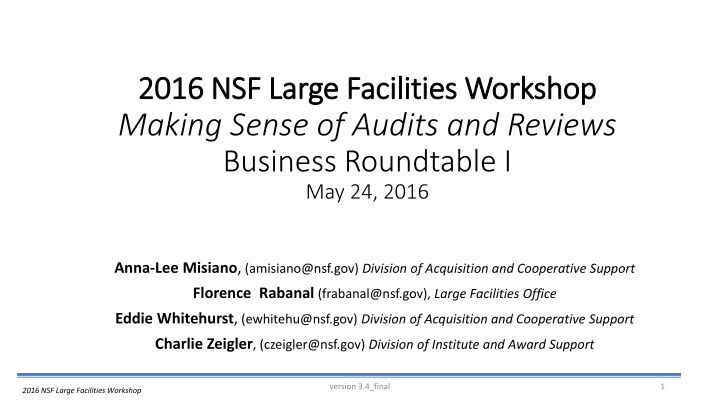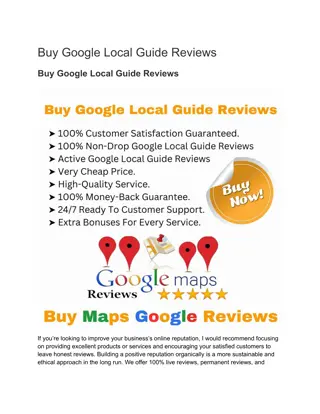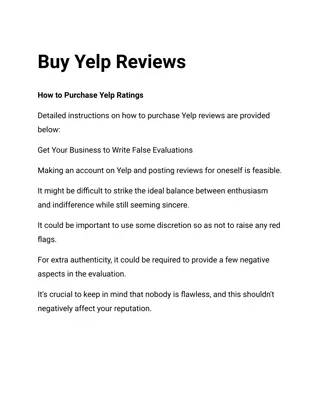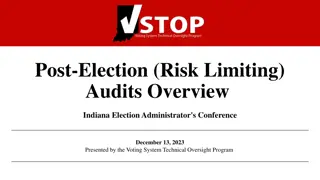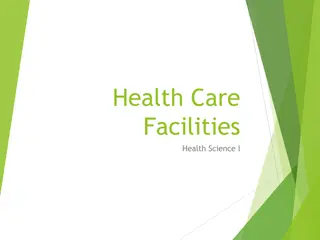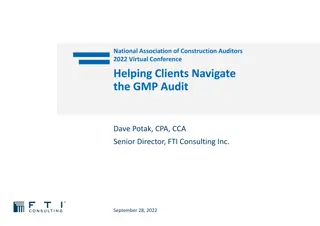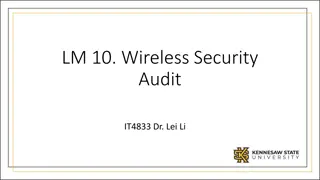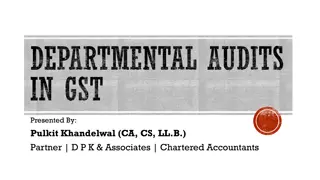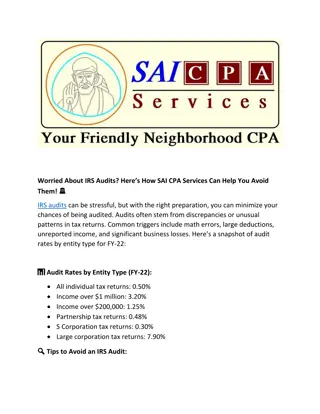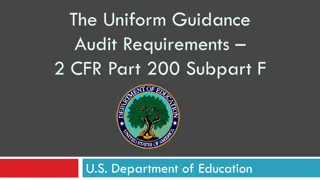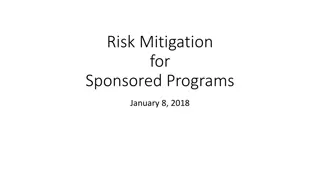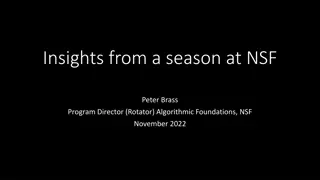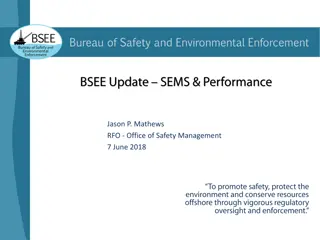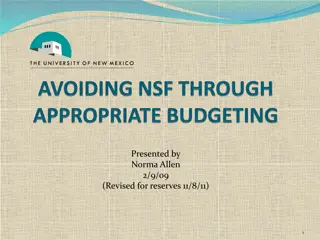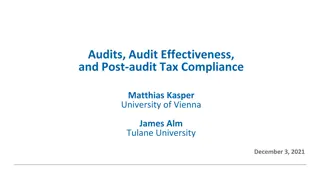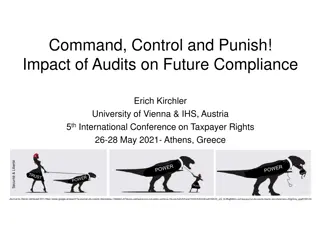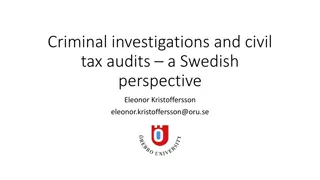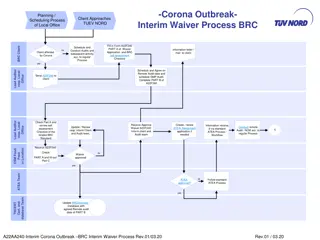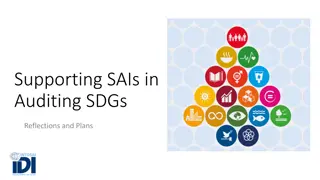NSF Large Facilities Workshop - Making Sense of Audits and Reviews
Workshop focused on improving outcomes of audits and reviews related to business operations and stewardship of Federal funds at NSF Large Facilities. Covers types of audits, business owners' roles, stakeholder engagement, and communication strategies.
Download Presentation

Please find below an Image/Link to download the presentation.
The content on the website is provided AS IS for your information and personal use only. It may not be sold, licensed, or shared on other websites without obtaining consent from the author.If you encounter any issues during the download, it is possible that the publisher has removed the file from their server.
You are allowed to download the files provided on this website for personal or commercial use, subject to the condition that they are used lawfully. All files are the property of their respective owners.
The content on the website is provided AS IS for your information and personal use only. It may not be sold, licensed, or shared on other websites without obtaining consent from the author.
E N D
Presentation Transcript
2016 NSF Large Facilities Workshop 2016 NSF Large Facilities Workshop Making Sense of Audits and Reviews Business Roundtable I May 24, 2016 Anna-Lee Misiano, (amisiano@nsf.gov) Division of Acquisition and Cooperative Support Florence Rabanal (frabanal@nsf.gov), Large Facilities Office Eddie Whitehurst, (ewhitehu@nsf.gov) Division of Acquisition and Cooperative Support Charlie Zeigler, (czeigler@nsf.gov) Division of Institute and Award Support version 3.4_final 1 2016 NSF Large Facilities Workshop
Presentation Goal, Objectives and Agenda Presentation Goal, Objectives and Agenda GOAL: TO IMPROVE OUTCOME of REVIEWS/AUDITS OBJECTIVES: Outline various types of Audits/Reviews Explain the overall purpose of each [Audit/Review] Identify the Business Owners associated with [Audit/Review] Highlight key interactions amongst Business Owners Engage stakeholders to gather input and ideas version 3.4_final 2 2016 NSF Large Facilities Workshop
PRESENTATION SCOPE and Content PRESENTATION SCOPE and Content Defines Audits/Reviews broadly as a careful/methodical check or review of something ; Recognizes the necessity of [audits/reviews] and fiduciary responsibilities inherent to the stewardship of Federal funds. Covers administrative business of audits/reviews of NSF Large Facility Portfolio, and NOT audits/reviews associated with project management (e.g., EVM, contingency) or scientific/technical components Presents an overview of what, why and who , NOT the details of how Complements related (more detailed) held in Business Roundtable II and III discussions. version 3.4_final 3 2016 NSF Large Facilities Workshop
Engaging Stakeholders Engaging Stakeholders How could NSF s communication and documentation strategies be adjusted to improve [external stakeholder] understanding of the variety of audits/reviews? Importance NSF Resources for Questions and Guidance NSF Coordination What are major challenges to employing suggested strategies for audit/review interactions? What steps could NSF take to further facilitate Recipient- implementation of the suggested improvement strategies for audits/review? version 3.4_final 4 2016 NSF Large Facilities Workshop
KEY [NSF] ASSURANCE MEMBERS/ AWARD MANAGEMENT: KEY [NSF] ASSURANCE MEMBERS/ AWARD MANAGEMENT: Division of Acquisition and Contract Support Division of Acquisition and Contract Support, , the Support Support, , and the and the Large Facilities Office Large Facilities Office the Division of Institution and Award Division of Institution and Award version 3.4_final 5 2016 NSF Large Facilities Workshop
AUDITS/REVIEWS: OVERVIEW BY TYPE AUDITS/REVIEWS: OVERVIEW BY TYPE AUDIT/REVIEW TYPE SIMPLIED DESCRIPTION BUSINESS OWNER STATUTORY Independent certified public accountant (CPA) Single Audit (A-133) ANNUALLY, to provide assurance to the US federal government as to the management and use of such funds by recipients such as states, cities, universities, and non-profit organizations RISK-BASED, to promote efficiency and effectiveness, through assessment of internal controls, financial management, information technology, and other systems that affect the operation of Agency programs. OIG-led/contracted NSF Office of Inspector (OIG) To investigate fraud, misuse of funds, and other violations of laws and regulations. NSF Division of Financial Management (DFM) Improper Payments ANNUALLY, to identify for reducing improper payments POST-AWARD MONITORING ADVANCED: focus on developing a reasonable assurance that institutions managing the higher-risk awards possess adequate policies, processes, and systems to properly manage federal awards RISK-BASED, to provide oversight/assurance of the suite of business systems (people, processes, and technologies) that supports the administrative management of a Facility (http://www.nsf.gov/pubs/2013/nsf13100/nsf13100.pdf) Business Systems Review NSF Large Facilities Office (LFO) version 3.4_final 6 2016 NSF Large Facilities Workshop
AUDITS/REVIEWS AUDITS/REVIEWS: OVERVIEW BY TYPE : OVERVIEW BY TYPE AUDIT/REVIEW TYPE SIMPLIED DESCRIPTION BUSINESS OWNER POST AWARD MONITORING, Cont. ADVANCED: focus on developing a reasonable assurance that institutions managing the higher-risk awards possess adequate policies, processes, and systems to properly manage federal awards RISK-BASED, to assess the extent that an awardee maintains a control environment within which awards are likely to be administered in compliance with Federal financial and administrative regulations and NSF agreement provisions (http://www.nsf.gov/bfa/dias/caar/docs/factsheet_desk.pdf) Advanced Monitoring Desk Review & Site Visit NSF Division of Institution and Award Support (DIAS) BASELINE: focus on post-award actions and financial transactions for most awardsandverify that awardee institutions implement awards in compliance with federal regulations and the terms and conditions of NSF award agreements RISK-BASED, reveal potential financial anomalies, inaccurate expenditure reporting, or evidence of a possible misunderstanding of, or non-compliance with, federal cash management requirements and/or NSF guidelines. Award Expenditure Transaction Testing NSF Division of Financial Management (DFM) Grants and Agreements Monitoring ONGOING, reveal a misunderstanding of, or non-compliance with, federal regulations and the terms and conditions of NSF awards NSF Division of Grants and Agreements (DGA) Active Payment/ACM$ Screening ONGOING, focused on daily, monthly, quarterly, and annual transactional activity. NSF Division of Financial Management (DFM) ONGOING, to verify that awardee institutions are properly reporting program income in accordance with NSF s policies. NSF Division of Financial Management (DFM) Program Income version 3.4_final 7 2016 NSF Large Facilities Workshop
AUDITS/REVIEWS AUDITS/REVIEWS: OVERVIEW BY TYPE : OVERVIEW BY TYPE AUDIT/REVIEW TYPE SIMPLIED DESCRIPTION BUSINESS OWNER MREFC LIFE-CYCLE BASED PRECONSTRUCTION STAGES: to assess whether [costs] they are reasonable and realistic as the design matures in preparation for the eventual construction award and subsequent operations awards Post CDR to only frame the initial parametric cost estimate, ensure coordination with the other NSF assurance divisions and offices, and identify areas of further refinements with the cost book and PEP that are necessary during the Preliminary Design Phase Division of Acquisition and Cooperative Support (DACS) High-Level Cost Analysis #1 POST PDR, to give confidence in the Not-To-Exceed estimated Total Project Cost (TPC) also identify areas of further refinement with the cost book and PEP that are necessary during the Final Design Phase. Division of Acquisition and Cooperative Support (DACS) Cost Analysis #2 ~90-180 DAYS PRIOR to PLANNED AWARD DATE, to give confidence in making the actual award for construction based on the best-available cost information, including updated cost proposal information received during the Final Design Phase. Cost Analysis #3 Division of Acquisition and Cooperative Support (DACS) AD HOC, To assess, through independent mechanisms, the credibility of the [Large Facility s] cost estimate. Independent Cost Estimate Review/s Large Facility Office (LFO) PRIOR TO MAKING CONST AWARD, to assess and determine if awardee and subawardee accounting systems are adequate for use with cost reimbursement type agreements . Division of Acquisition and Cooperative Support (DACS) Accounting System version 3.4_final 8 2016 NSF Large Facilities Workshop
AUDITS/REVIEWS AUDITS/REVIEWS: OVERVIEW BY TYPE : OVERVIEW BY TYPE AUDIT/REVIEW TYPE SIMPLIED DESCRIPTION BUSINESS OWNER MREFC LIFE-CYCLE BASED, Cont. CONSTRUCTION AND OPERATION STAGES: to assess whether [costs] they are reasonable and realistic as the design matures in preparation for the construction award and subsequent operations awards RISK-BASED, to provide oversight/assurance of the suite of business systems (people, processes, and technologies) that supports the administrative management of a Facility (http://www.nsf.gov/pubs/2013/nsf13100/nsf13100.pdf) Business Systems Review NSF Large Facilities Office (LFO) PRIOR TO MAKING CONST/OPS AWARD, to assess and determine if awardee and subawardee accounting systems are adequate for use with cost reimbursement type agreements . Accounting System, Other Business Systems Division of Acquisition and Cooperative Support (DACS) AT LEAST ANNUALLY, AWARD [>$100M], to assure the existence of adequate controls which will prevent or avoid waste, fraud, and abuse and inefficient practices. Division of Acquisition and Cooperative Support (DACS) Cost Incurred Audit ALL AWARD ACTIONS> $10M, over all award years funded at that time. Ensure budgeted costs are reasonable and realistic to accomplish project scope. Division of Institution and Award Support (DIAS) Budget Review GENERALLY ANNUALLY, with provisional to final indirect cost rates. Where NSF acts as cognizant Federal agency, review of indirect cost pool expenses may include transaction testing. Indirect Cost Rate Negotiation Division of Institution and Award Support (DIAS) version 3.4_final 9 2016 NSF Large Facilities Workshop
NSF Post Award NSF Post Award Monitoring Monitoring Baseline monitoring, executed in the course of post-award administration, seeks to verify that awardee institutions implement awards in compliance with federal regulations and the terms and conditions of NSF award agreements. NSF s advanced monitoring activities focus on developing a reasonable assurance that institutions managing the higher-risk awards possess adequate policies, processes, and systems to properly manage federal awards. version 3.4_final 10 2016 NSF Large Facilities Workshop
MREFC Life MREFC Life- -Cycle Based View: Cycle Based View: [NSF [NSF- -coordinated] Audits/Reviews coordinated] Audits/Reviews BUSINESS SYSTEMS REVIEW, ideally prior to transition to Operations, in addition to periodically Operations Phase, if employed COST ANALYSES, immediately following Conceptual Design Review, Preliminary Design Review and Final Design Reviews. ACCOUNTING SYSTEM and OTHER BUSINESS SYSTEMS, prior to entering any large facility Construction or Operations [>$100M] Cooperative Agreements REVIEW OF INDEPENDENT COST ESTIMATE , prior to completion of second cost analysis. Other internal NSF cost analyses may be used. COST INCURRED AUDIT, at least annually for award [>$100M], to assure the existence of adequate controls which will prevent or avoid waste, fraud, and abuse and inefficient practices. BUDGET REVIEW, ALL AWARD ACTIONS> $10M, over all award years funded at that time. Ensure budgeted costs are reasonable and realistic to accomplish project scope. BUSINESS SYSTEMS REVIEW, ideally conducted during CDR phase and prior to PDR, if employed INDIRECT COST RATE NEGOTIATION, GENERALLY ANNUALLY, with provisional to final indirect cost rates. Where NSF acts as cognizant Federal agency, review of indirect cost pool expenses may include transaction testing. version 3.4_final 11 2016 NSF Large Facilities Workshop
Strategies for Improving Audit and Review Strategies for Improving Audit and Review Interactions and Outcomes Interactions and Outcomes ROLES AND RESPONSIBLITIES Identify single point of contact/dedicated person, in appropriate organizational role Coordinate, coordinate, coordinate Organization-wide Maintain routine and open communication with your auditors/reviewers PLANNING Plan ahead, don t wing it Create deliberate internal and external communication strategies, include routine interactions Provide staff training DOCUMENTATION Organize well packaged and externally-oriented materials Avoid the extremes, too much, too little Provide easy and timely access Assure underlying systems are robust version 3.4_final 12 2016 NSF Large Facilities Workshop
Engaging Stakeholders Engaging Stakeholders How could NSF s communication and documentation strategies be adjusted to improve [external stakeholder] understanding of the variety of audits/reviews? Importance NSF Resources for Questions and Guidance NSF Coordination What are major challenges to employing suggested strategies for audit/review interactions? What steps could NSF take to further facilitate Recipient- implementation of the suggested improvement strategies for audits/review? version 3.4_final 13 2016 NSF Large Facilities Workshop
